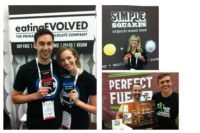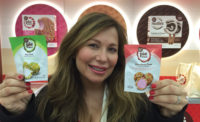When I began covering Natural Product Expos and Fancy Food Shows more than 15 years ago, the target demographics fell into one of two categories:
- People buying natural products favored health over taste.
- People buying specialty food taste over taste over health.
Not so today. Both audience preferences have evolved and now overlap, like partially intersecting ven diagrams.
The natural products marketplace can act as an incubator for new ingredient concepts.
Ancient grains, pea protein and kale are examples of three recent food trends that first appeared as healthy ingredient alternatives manufactured by a start-up and sold in the natural foods segment.
As food makers improved the taste of their formulations, these ingredients started appearing in specialty foods.
And with more consumers being introduced to the ingredients, market demand builds. Then, as a final chapter in their evolution, a mega-manufacturer purchases the start-up and cranks up the volume.
Natural Products Expo East is the largest organic and natural food and beverage event on the East Coast.
According to organizers, New Hope Natural Media, 25 percent of the 1,363 exhibitors at this year’s event (which ran Sept. 16 to 19) were new brands utilizing the Expo as their entrée to a national marketplace.
So, that explains my excitement each year at covering the Natural Products Expo — it’s an opportunity to spot today’s food category disruptors, which will evolve into tomorrow’s premium confectionery and snack stars.
These five market disruptor food category picks are products aimed at millennials, although other age groups would also find them attractive. The products are made with all-natural or organic ingredients, have clean labels and are convenient to consume.
Why are millennials such an important target market?
In a survey conducted this summer by Mintel for the Specialty Food Association and published as Today’s Specialty Food Consumer 2015 report, nearly half (47 percent) of the respondents reported purchasing specialty food within the past six months. Of this group, millennials (ages 21 to 38) were the predominant core consumer.
Among specific consumer behavioral traits, they value foods that are healthy, convenient and — endearing to new product development efforts — they also are willing to try new products.
And two of the five disruptor products were pitched successfully on Shark Tank this fall. This outcome makes the American reality TV show an increasingly important contender for funding innovative snack and confectionery companies.
Below is a look at five products that have amazing potential to disrupt the candy and snack category:
1. Artisan meat jerky

The first product category disruptor was artisan meat jerky.
The market research firm SPINS reports that sales of jerky and other meat snacks in natural and specialty grocery channels rocketed 69 percent to $17 million last year.
While impressive, that sales figure is small chops when compared to the entire jerky and meat snacks market, including sales through c-stores, a predominant channel, which IRI pegged at $1.5 billion.
However, Hershey’s purchase last year of Krave for about $300 million has brought a lot of recognition to the artisanal jerky movement. At Natural Product Expo East it seemed that there was an artisan jerky exhibitor on every aisle.
What’s driving this trend?
“I think the trend is getting a boost from the paleo trend which keeps on edging mainstream. Additionally, there is a trend toward more savory snacks, as sugar is the new health villain, and that seems to be driving activity in meat snacks as an alternative to snack bars,” explains Innovation Insights Director Tom Vierhile with Progressive Digital Media.
Or this finding from Euromonitor’s 2014 Sweet & Savory Snacks in the U.S. report: "A recent trend among consumers of viewing protein as an effective appetite suppressant and energy booster has further helped jerky to be perceived as a smart snacking option."
So how is artisan jerky disrupting the meat snack market?
Enterprising food artisans took a gas station snack staple and upscaled it — in went premium cuts of beef; out went the junk.
“Our jerky has no ten-syllable ingredients; only those found in your kitchen cupboard,” explains Field Trip jerky company co-founder Matthew Levey.
The company was founded five years ago by three guys who ditched their corporate careers for something tastier, reminiscent of what they ate on their adolescent field trips. Their first sales promotion activities were to bike around Manhattan and knock on grocery store doors.
Their timing was excellent. Field Trip jerky is now sold in 20,000 stores, and recently Starbucks picked up the brand for sale in its stores nationwide. In August, the company secured its first investor, the former ceo of Coach. Field Trip jerky is available in six flavors, four with beef, Original, Honey Spice, Roasted Sesame and Teriyaki; and two with turkey, Crushed Chilies and Cracked Pepper. (S.R.P.: 2.2-oz. bag, $6.50).
Another exhibitor, Three Jerks, launched in 2013 with the highest grossing Kick Starter beef jerky campaign at the time ($46,000 in 30 days). The company’s point of differentiation is using only filet mignon.
“We call it red neck charcuterie,” says company co-founder Daniel Fogelson.
Three Jerks, which is great protein source (22 to 26 grams per pack), sports a clean label and is convenient to eat, joins other artisan brands an an attractive snacks for folks on the go.
Interestingly, Three Jerk’s customer profile, according to Fogelson, is 45 percent female.
“Our specialty food product is attractive to more than just bearded men,” Fogelson says.
And, company sales have increased 100 percent month over month.
Three Jerksis available in four flavors, Original, Memphis, Chipotle, Hamburger and the sweet/savory Maple Bourbon Churro. (S.R.P.: 2oz. bag, $11.99)
Expo East exhibitor Lawless Jerky is another popular artisan brand.
Its name was inspired by the founder, Matt Tolnick, who quit a law practice two years ago to launch his startup. Lawless hand crafts its jerky from grass-fed beef imported from Australia and New Zealand, believing that such meat is tastier and healthier. Its differentiating factor is the use of unusual flavors with a sort of “millennial craft feel” notes Sales Manager Steve Miller. Flavors include Sweet Sriracha, Aloha Teriyaki, Japanese Curry, Pho, Mango Habanero and Honey Chipotle. BBQ Sparerib is a new flavor, but is obviously not grass fed. (S.R.P.: 2-oz. bag, $5.99)
2. Snack Bars

A second product category disruptor and Expo exhibitor was snack bar maker Mediterra Nutrition Company. The company was founded 12 months ago by Greek born Telemaque Lavidas who moved to New York for college and wanted to continue eating the way he had growing up — on the Mediterranean Diet.
The popularity of the Mediterranean diet has been buoyed by a stream of general media stories touting its health benefits.
“We are the only company based upon this diet,” says Paul Pruett, ceo. “Every ingredient in our bars is native to the Mediterranean region.”
Mediterra also tapped into another consumer trend sweeping the snack bar world, namely savory snacks.
“Consumers are tired of the same old sweet bars; they are so excited to have an option,” he says.
At this year’s Expo, the company added two more savory bars, Kale and Pumpkin Seed and Bell Pepper and Green Olive, to its existing line of Sun Dried Tomato and Basil and Black Walnut and Olive.
Pruett also credits part of the growing popularity of his company’s bars to the fact that consumers are eating them in mid- to late-afternoon — a different eating occasion than sweet bars. [(S.R.P.: 1.2-oz. bar, $1.99)
3. Nut Butters

A third product category experiencing market disruption that I found at the Expo was nut butters.
How much more innovation can a product with typically only two or three ingredients profitably support, you might ask? And, has the Justin’s Nut Butter juggernaut left any room for competitors? The answer, gentle reader, is that there is plenty of innovation in this nutty category.
Yumbutter didn’t enter the food world as a nut butter maverick. But after selling glass jars of nut butter for three years at local Madison, Wis., farmers markets, the local coop and, later, Whole Foods, the owners needed a break-out product if they were to survive and have the impact they desired.
Then inspiration struck.
“People’s lifestyles are not slowing down, and many don’t want to sacrifice food quality for convenience,” says co-founder Matt D’Amour. “They want superior nutrition options that match their active lifestyle. We feel that functional nut butter on-the-go can do that.”
Following this line of reasoning, Yumbutter started packaging its nut butters in side-spouted, multi-serving pouches that enable a multi-serving, mess-free, go-anywhere delivery system.
Additionally, the company blended its butters with super foods — chia seeds, hemp seeds and goji — to add an extra, good-for-you booster.
Yumbutter’s current product lineup includes Superfood Almond, Superfood Sunflower and Superfood Peanut. Scheduled for launch in January 2106 are three new products: Superfood Cashew, Chocolate Espresso (peanut butter with raw cacao, vanilla and cinnamon) and Plant Protein + Probiotic (almond butter with added protein from brown rice and BC30 probiotic). (S.R.P.: 7-oz. jar, $5.99).
4. Baobab and Moringa

And speaking of superfoods, how about those that are tasty, highly nutritious and a potential economic godsend for the subsistence farmers who grow them? It’s a trifecta of food science.
The superfoods in question are baobab and moringa.
Nick Salter believes that there is a lot of love about baobab. Plus his company, Aduna, was the first company to popularize it in Europe.
Powder made from the dried fruit is high in antioxidants, fiber and Vitamin C — a characteristic that underlines baobab’s nickname of the “tree of life.”
The powder has a pleasant taste that Salter described as sherbet-like citrusy.
In Europe, baobab has shown up in chocolate, ice cream, kale chips and even gin.
U.S. food product developers have just begun to explore baobab’s potential, particularly mixed in smoothies, shakes and yogurt and as a dessert topping.
Aduna sells bulk BaobabSuperfruit Powder and Baobab & Pineapple Raw Energy Bars containing 2 teaspoons of baobab powder. Both products this year won Great Taste awards, the British equivalent to the SOFIs. (S.R.P.: 1.6 oz., $N/A)
Meanwhile Moringa Superleaf Powder is made from dried leaf powder.
Salter extolled the tree as the most nutrient-dense plant on earth, high in antioxidants (six times higher than goji berries) and double the number of essential vitamins and minerals as spirulina.
“In the next few years, moringa will steal the crown from spirulina or chlorella as being the high benchmark of nutritious ingredients,” he says.
In addition to commercializing these two superfoods, the London-based company’s mission is to make a social impact in Africa.
Baobab grows in 32 countries across Africa, in some very impoverished dry areas where very little else can be grown.
“Part of that demand creation is challenging the way people perceive African products,” Salter says. “A lot of African products are usually sold as a ‘pity purchase — fair trade, buy this product and help this woman buy a bicycle.’ We want people to purchase our products because they love them.”
The packaging, which is is based upon African wax print fabrics that you see women wear in the local markets, highlights the company’s ties to the continent.
And just a week prior to Expo East, Aduna received a United Nations Global Sourcing Council Award for sustainable sourcing.
5. Edible glassware

The fifth food category market disruptor was the most unique: edible glassware.
This concept was born five years ago by two graduates from the New York City-based Parsons School of Design. As a professional challenge, they entered the Jell-O mold competition and won a prize for “structural integrity.”
That success lead the duo to “something fun and functional: edible cups as a replacement for plastic,” reminisces co-founder Leigh Ann Tucker.
The two continued to tinker and improve their product and finally launched it as Loliware.
“We consider Loliware the leader of a new category we've coined "biodegr(edible)," explains Tucker.
For sales potential, she identifies bioplastics as the most analogous market, which is a $1 billion category and forecast to grow to $20 billion by 2020.
This October they pitched their company on Shark Tank and scored a $600,000 investment from Mark Cuban and Barbara Corcoran.
Loliware cups are made with organic tapioca syrup, agar-agar and organic sugar. They are gluten-free, gelatin-free, and able to serve beverages ranging from cold to room temperature, alcoholic or not.
They also come in five flavors to correspond to all the beverages: Yuzu Citrus, Tart Cherry, Vanilla Bean, and Matcha Green Tea. For example, Yuzu Citrus, a blend of yuzu and pink grapefruit, “pairs well with champagne, fresh cocktails, summer spritzers and fruity sorbets.”
The cups are 5 ounces, and are sold as a 4-pack for $11.99. Additionally, 1-oz. taster cups and larger 10-12-oz. food service size cups are in development.
These – and other − remarkable new products exhibited at Natural Products Expo East, with aisles chock full of literally category— and not just line-extending products — is a great indicator that the entrepreneurial spirit is alive and well. Amen.
Curtis Vreeland, president of Vreeland & Associates, specializes in confectionery market research. He has been spotting trends in the premium confectionery sector for Candy Industry Magazine for seven years.







